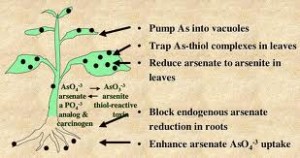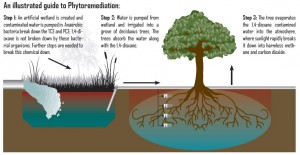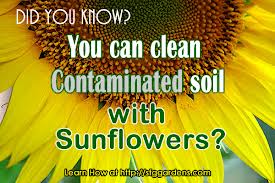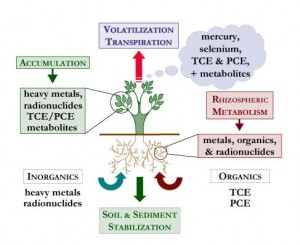A student of class 2nd is taught about the various benefits of trees. The trees being helpful to the environment, as they provide us oxygen, the use of their wood, the consumption of fruits, the source of raw materials for various industries like rubber, and other helpful properties. You have learnt how through the process of photosynthesis, the plants are able to convert carbon dioxide into oxygen, and in this way, reduce the carbon emissions in the atmosphere, ultimately reducing air pollution. But have you ever heard about the plants which can also cure water and land pollution? There have been huge treatment plants set up by the governments which cure water and soil, but any natural set ups?
Yes, I am talking about phytoremediation (literally meaning plant and restoring balance i.e. restoring balance through plants). The roots of these trees have the ability to treat the contaminated soil, which is filled with minerals and chemicals. What these plants do is that they contain, degrade or eliminate some pollutants from ground, water and air. These pollutants include metals pesticides solvents and other chemicals.

Phytoremediation can be applicable with huge success in the areas where the waste materials from the industries are dumped, generally where there is an accumulation of metals and chemicals. These chemicals are accumulated near the roots of these trees, which then do not allow them to mix into the soil, therefore decreasing their harmful effects. The process can be used to inhibit the growth of many elements in the soil or water, the major ones being lead, uranium and arsenic.
Phytoremediation works under various ways of approach. The first one being phytoextraction. In this, the elements which are harmful for the soil are required for the growth of the plants. The plant uptakes these elements through the roots and manages to reduce pollution. Phytostabilization reduces the mobility of these elements by accumulating them near the roots of the soil. Phytotransformation and Phytostimulation refer to the degrading of these chemicals into less toxic elements, either through the plant only or initiating other micro organisms.

Now, what can be done to enhance such organic solutions? The first thing is planting of the phytoremediate plants, which are Neem, Peepal, Sunflowers, Barley, Poplar, Willow, Hydrilla etc. These can be done in your gardens, which will keep the soil and water clean. This will also keep the fruits and vegetables growing in your garden away from toxic elements, thus, ensuring a good health.
On the larger level, this can be adopted as an effective technique as government projects. For example growing of these plants on the banks of river Yamuna will improve the purity of the river and decrease the pollution caused by the large quantities of industrial waste released into the water. Similarly, the areas can be picked where the land or water is becoming contaminated and this technique can be very helpful.

Although there is a huge disadvantage of this process- the long term commitment is required to grow these plants, because of the unfavorable soil and water conditions. So, it will not be like a water treatment plant which can start working once it is set up. The growth of trees will require some time, but on a long run, the process can turn out to be very beneficial for environment.
There have been a large number of studies which point at the role of algae in curing water pollution through phytoremediation. So, this can be done as a process of cleaning up still water bodies like lakes and ponds. Planting some plants in these water bodies, like Hydrilla and weeds can help considerably to treat the elements like arsenic and boron in the water bodies.

So, the best thing to do right now, to treat the evil of pollution is to plant some phytoremediate plants, which will turn out to be an organic way of curing pollution, which otherwise can become very harmful for your health as well as for the environment.
As it goes, “The best time to plant a tree was twenty years ago, the second best is now.” Very true it is, because it is the time to act, the time to take decisions, the time to set up priorities, before it is too late. The process suggested in this article has a lot of potential to become the savior of the planet from pollution. Adopting this, on both small scale as well as larger scales, would be a moving a step towards following green living and saving the planet.

Leave a Reply